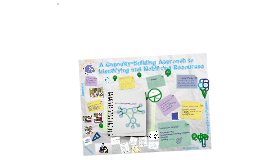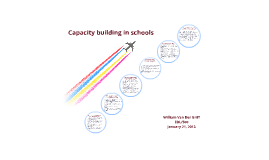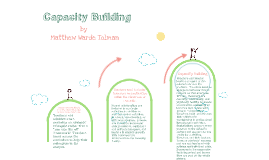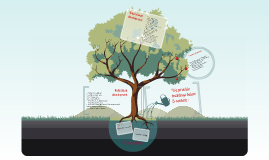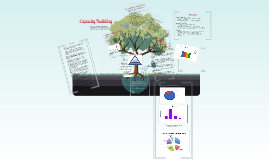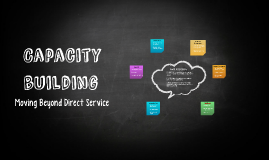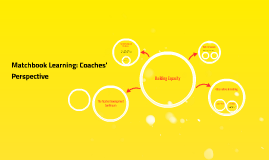Capacity Building
Transcript: Capacity Building What is Capacity Building? History of Capacity Building Before the Capacity BUiding Movement: Strategic Planning Strategic Planning is defined as a process through which an organization agrees on- and builds commitment among key stakeholders to things that are essential to its mission and are responsive to the environment. (Worth, 2012, 168-169) Early 1990s- Interest in capacity building was sparked by books & articles by critics about Strategic Planning Late 1990s- Early 2000s Shift in emphasis from replicating programs to building stronger nonprofits by increasing efficiency and sustaining expanding programs (Worth, 2012, p. 193). 2007- Recession- emphasis on collaboration and merging of nonprofits, as to not duplicate services. http://www.501commons.org/resources/capacity-building-organizations Funding Capacity Building through: Grants, Foundations, Fundraising, and Internal Resources. Theoretical Base of Capacity Building 100%of the respondents claimed that capacity building increased efficiency in their organization Examples of effective capacity building include: Upgrading computers/servers to better support our work without having to put out tech fires all the time Training, reorganizing, and streamlining our program goals Increasing our fundraising efficiency •“Evaluation capacity building is the process of improving an organization’s ability to use evaluation to learn from its work and improve results” (Major & Brennan, 2011, p. 4). •Why is it important? Evaluating capacity building is a tool to help increase learning and make changes that strengthen nonprofit organizations through more effective planning, acting, advocating, funding, and acquiring resources. • How do your organization evaluate its capacity building efforts? •Did your organization use the results from the evaluation to alter capacity building techniques? Yes 10 No 3 Marguerite Casey Foundation Organizational Assessment Tool “Changes in funder requirements are the primary, if not sole, catalyst for making organizational changes” (p. 8) Capacity building is defined as “whatever is needed to bring a nonprofit to the next level of operational, programmatic, financial, or organizational maturity, in order to more effectively and efficiently fulfill its mission” (National Council of Nonprofits, 2012, para. 1). “building the capacity to fulfill an organization’s mission” (Jacobs, B., 2001, p. 1). Unique to each organization A holistic view of the organization is necessary to function in the most efficient manner (McKinsey & Company, 2001) Types of Capacity Building 1.Leadership 2.Adaptive 3.Management 4.Operational (Marguerite Casey Foundation,2012.) By: Anna Valkov, Thuy Huynh, Danielle Rucci, Taylor Callaham, Christina Woeck, & Isabela Ordóñez References What Now? Cravens, X., & Hallinger, P. (2012). School leadership and change in East Asia: Building capacity for education reform. Peabody Journal of Education, 87(2), 157-161. de Groot, F. P., Robertson, N. M., Swinburn, B. A., & de Silva-Sanigorski, A. M. (2010). Increasing community capacity to prevent childhood obesity: Challenges, lessons learned and results from the romp & chomp intervention. BMC Public Health, 10, 522-529. Ebrahim, A. (2009, October 29). Rethinking capacity building. Retrieved from http://www.capacity.org/capacity/opencms/en/ topics/organizational-development/ rethinking-capacity-building.html Jacobs, B. (2001). Echoes from the Field: Proven capacity-building principles for nonprofits. Retrieved from http://www.innonet.org/resources/node/172 Kapucu, N., Augustin, M.E., & Krause, M. (2007). Capacity building for community-based small nonprofit minority health agencies in central florida. The International Journal of Volunteer Administration, 24(3), 10-17. Retrieved from http://www.ijova.net/PDF/VOL24_NO3/IOJVA_VOL24_NO3_Kapucu_Capacity%20Building%20for%20Community.pdf Major D., & Brennan K. (2011). How do we build the capacity of nonprofits to evaluate, learn, and improve? Grantmakers For Effective Organization. Washington D.C. Retrieved from https://courses.wwu.edu/courses/1/B41226-201240/groups/_28208_1//_1588154_1/2011%20-%20Capacity%20Building.pdf. Marguerite Casey Foundation. (2012). The Marguerite Casey foundational organizational capacity assessment tool. Retrieved from http://caseygrants.org/resources/org-capacity-assessment/ McKinsey & Company. (2001). The capacity framework: In effective capacity building in nonprofit organizations. Retrieved from http://www.vppartners.org/sites/default/files/reports/full_rpt.pdf. Millesen, J. L., Carman, J. G., & Bies, A. L. (2010). Why engage? Understanding the incentive to build nonprofit capacity. Nonprofit Management & Leadership, 21 (1), 5-20. National Council of Nonprofits. (2012). Why capacity building is needed. Retrieved from http://www.councilofnonprofits.org/why-capacity-building Worth, M. J. (2012). Nonprofit management, principles and practice. Sage Publications, Inc. Capacity building in






